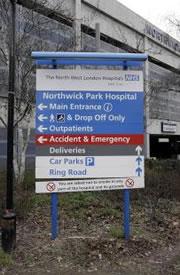 Animal tests had given little sign that the clinical trial in humans would go terribly wrong, landing the experimental subjects in the hospital.Edmond Terakopian/PA.
Animal tests had given little sign that the clinical trial in humans would go terribly wrong, landing the experimental subjects in the hospital.Edmond Terakopian/PA.Immunologists have a new theory to explain why the devastating effects of the experimental drug TGN1412 were not spotted in animal tests. The 'superantibody' drug put six volunteers in intensive care in a London hospital last March.
Animals used in preclinical tests for TGN1412, researchers now say, lack a crucial set of immune cells because they are deliberately shielded from infections in the lab.
Within hours of being injected with the drug, the victims suffered widespread swelling and multiple organ failure. Subsequent investigation showed that this was due to a 'cytokine storm' — widespread overreaction of immune cells called helper T cells, which kick other parts of the immune system into action.
This effect was not seen in the monkeys used for preclinical trials because they do not have as many helper T cells, claims lead researcher Federica Marelli-Berg of Imperial College London, UK. She presented her work on 25 January at the Club de la Transplantation conference near Paris, France.
This is a result of the near-sterile conditions in which valuable lab animals are kept, which prevents them developing a greater host of immune cells through exposure to everyday infections, argues Marelli-Berg.
Sticky situation
Many of the army of helper T cells are so-called 'memory cells', which are activated by the binding of a specific antigen encountered in the past. This allows the body to mount a swift defence against familiar pathogens — the principle on which vaccination works.
“The effects would have been very different in humans and animals.”
Federica Marelli-Berg
Imperial College London
The drug's developers, the German biotechnology firm TeGenero, intended it to target not T helper cells but a different class of immune cells, in an effort to combat diseases such as arthritis. But TGN1412 had an unexpected effect. Because the drug overrides the control mechanism that allows certain immune cells to respond only to antigens they have previously come across, large numbers could be activated without encountering their specific antigen. In humans, the range of activated cells was unexpectedly large.
Whereas lab monkeys lack memory cells, the human volunteers at Northwick Park Hospital had plenty of them. Excess activation of memory cells might also explain why the victims suffered such widespread organ failure when these cells usually remain in the bloodstream. Marelli-Berg and her colleagues have discovered, in mice, that T cells activated by their CD28 receptors — the receptor to which TGN1412 binds — become more 'sticky', which enhances their dispersal through the blood-vessel walls and into other tissues1.
"The human subjects' memory T cells lost their sense of direction and started migrating into several areas of the body where they were not supposed to go, and caused damage," she says.
More to the story
The theory once again raises the question of whether clinical trials should have been allowed to proceed for such a potent drug candidate. A subsequent investigation by the British Medicines and Healthcare Products Regulatory Authority declared that the disaster was caused by the drug itself, not by any wrongdoing on the part of those administering the trials.
As part of a report into how to minimize the risks of future clinical trials, immunologist Stephen Inglis of the National Institute for Biological Standards and Control in London developed a new test, using human cells in a test tube, that could have spotted the risk of a cytokine storm (see 'New test could weed out dangerous drug trials').
ADVERTISEMENT
Inglis also doubts that Marelli-Berg's theory represents the whole story. Monkey cells did not respond to his test in the same way, suggesting that there is something fundamentally different about the two species' cells, rather than simply a question of which cells are present.
What's more, he says it is unclear whether or not lab monkeys do indeed have less-developed immune systems. "They're not like mice," he says. "Colonies of monkeys live in groups, they're not in individual cages, they do get infections and they're not pristine. We would now recommend using human cells for preclinical trials. But whether that is the cause is a different thing."
Visit our lightthrownontragic_d.html">newsblog to read and post comments about this story.
Imperial College London
